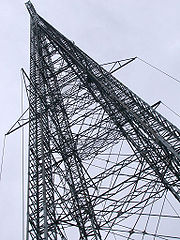
Sölvesborg medium wave transmitter
Encyclopedia



Radio
Radio is the transmission of signals through free space by modulation of electromagnetic waves with frequencies below those of visible light. Electromagnetic radiation travels by means of oscillating electromagnetic fields that pass through the air and the vacuum of space...
station at Björkenabben on the peninsula Listerlandet, inaugurated 30 May 1985.
The station most recently transmitted on 1179 kHz
Mediumwave
Medium wave is the part of the medium frequency radio band used mainly for AM radio broadcasting. For Europe the MW band ranges from 526.5 kHz to 1606.5 kHz...
, used by Radio Sweden International (until October 30, 2010), and is owned by Teracom
Teracom
Teracom is a terrestrial broadcast transmission service company owned by the Swedish Government. Teracom owns all Swedish broadcast transmission sites, and distributes all terrestrial radio and TV channels, private as well as public-service, analogue as well as digital.Teracom Components is a...
.
Technical specifications
The station is situated outside SölvesborgSölvesborg
Sölvesborg is a locality and the seat of Sölvesborg Municipality in Blekinge County, Sweden with 7,883 inhabitants in 2005.Sölvesborg is, despite its small population, for historical reasons normally still referred to as a city...
, far out on the peninsula Listerlandet, right on its outer point Björkenabben at the seaboard of the Baltic Sea
Baltic Sea
The Baltic Sea is a brackish mediterranean sea located in Northern Europe, from 53°N to 66°N latitude and from 20°E to 26°E longitude. It is bounded by the Scandinavian Peninsula, the mainland of Europe, and the Danish islands. It drains into the Kattegat by way of the Øresund, the Great Belt and...
. The station takes advantage of a phenomenon called "sea gain", which means that the signal is amplified by the surrounding sea, to improve coverage. Two 135 metres (442.9 ft) high steel lattice towers work as antennas and are fed half way up by eight feeders from a feeder house beneath each of the two antennas, where the feeders from the transmitter are connected.
The antenna currencies are phase offset to achieve the directionality that has been decided by international law. One of the antennas is fed with 450 kW and the other one only with 150 kW. The station achieves most of its aiming towards west and north. It must be lowered towards east and south to not interfere with other stations on the same frequency. The station shares the frequency with five other stations in Europe
Europe
Europe is, by convention, one of the world's seven continents. Comprising the westernmost peninsula of Eurasia, Europe is generally 'divided' from Asia to its east by the watershed divides of the Ural and Caucasus Mountains, the Ural River, the Caspian and Black Seas, and the waterways connecting...
. The transmission coverage area is directional the 70° and 270° azimuths.
The transmitter has a power of 600 kW (PEP) and, together with the antenna gain, the output power is 2000 kW (ERP).
Prior to Sölvesbörg, a 100 kW site in Hörby
Hörby
Hörby is a locality and the seat of Hörby Municipality, Skåne County, Sweden with 6,651 inhabitants in 2005.- References :...
had been in use since 1947, but its equipment had aged significantly. The staff prayed every morning for the old station to start. The Hörby transmitter was scrapped directly after Sölvesborg went into service.
On 14 January 1985, construction ended, and shortly after, adjustment began.
On 30 May 1985, the station was inaugurated by Televerket Radio together with representatives from Sölvesborgs kommun and Sveriges Radio
Sveriges Radio
Sveriges Radio AB – Swedish Radio Ltd – is Sweden's national publicly funded radio broadcaster. The Swedish public-broadcasting system is in many respects modelled after the one used in the United Kingdom, and Sveriges Radio - like Sveriges Television - shares many characteristics with...
.
Construction works
Construction began in 1982. The antenna towers took only three months to assemble. Smedjebacken-Boxholm made the drawings and Wibe assembled them. They only weigh 70 tonnes each. In the ground around the towers 8 km of copper wire were dug down which ends up in large copper plates to get optimal grounding. Two 350m long feeder cables isolated by compressed air go from the station building to each of the antennas. The transmitter is a TelefunkenTelefunken
Telefunken is a German radio and television apparatus company, founded in Berlin in 1903, as a joint venture of Siemens & Halske and the Allgemeine Elektricitäts-Gesellschaft...
S4006. Major parts of the transmitter are cooled by water with forced ventilation on some exposed parts. The efficiency lays around 73% which is almost as high as theoretically possible.
It cost 25 million Swedish krona
Swedish krona
The krona has been the currency of Sweden since 1873. Both the ISO code "SEK" and currency sign "kr" are in common use; the former precedes or follows the value, the latter usually follows it, but especially in the past, it sometimes preceded the value...
to construct the site. It features 1500 tonnes of concrete, 140 tonnes of steel, and 100 km of copper thread and was built with 20,000 man-hours of labor.
The station building is prepared for one more transmitter.

